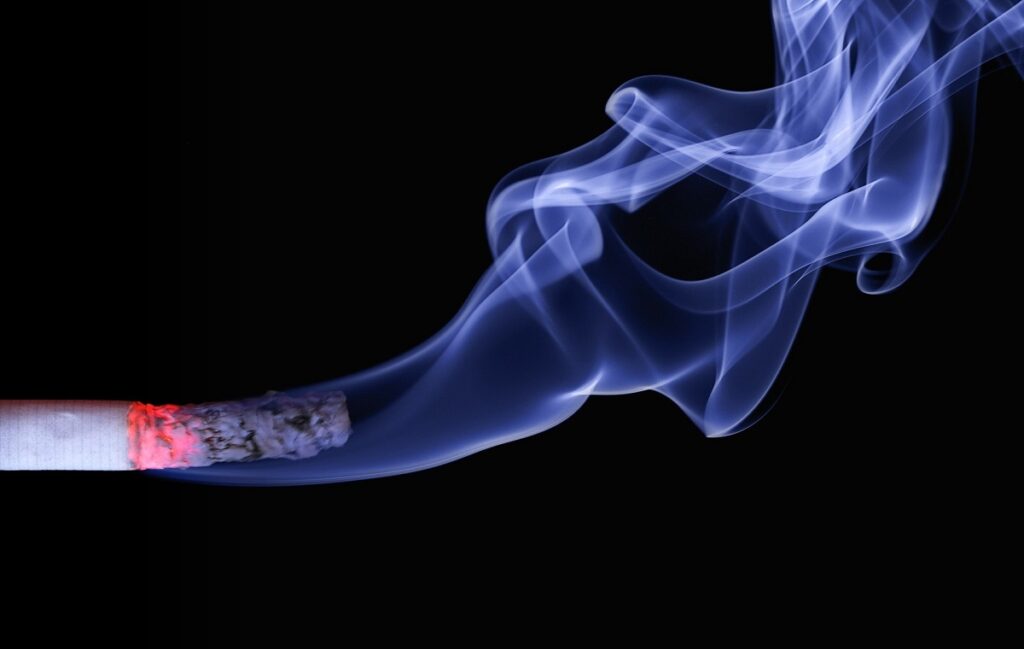
Fires continue to burn in southeast Canada and the northeastern United States and the overall weather pattern is concentrating much of their smoke over portions of New Jersey, Pennsylvania, New York, Connecticut, Rhode Island, and Massachusetts today. The air quality in New York City is expected to be so bad today that it would be healthier to smoke a 1/2 pack of cigarettes today than it would be to simply breath in outdoor air all day. The same is true for areas nearby from Pennsylvania to Massachusetts.
In the United States, air quality is rated by an Air Quality Index established by the Environmental Protection Agency (EPA). The index, known as AQI for short, is an index the EPA uses to report on daily air quality; it describes how clean or unhealthy air is in a particular area and helps inform people of the types of health impacts that could happen as a result of exposure to the air. According to the EPA, the AQI focuses on health effects you may experience within a few hours or days after breathing unhealthy air. The AQI is calculated for four major air pollutants regulated by the Clean Air Act: ground-level ozone, particle pollution, carbon monoxide, and sulfur dioxide. For each of these pollutants, the EPA has established national air quality standards to protect public health.
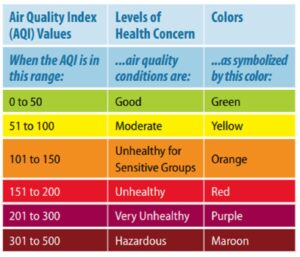
The higher the AQI value, the more hazardous the air is for people. An AQI value of 50 or less generally corresponds to good quality air with little or no potential to affect public health. When AQI values reach or exceed 100, the EPA considers the air unhealthy. For readings near 100, air quality may be an issue for certain sensitive groups of people, such as those with respiratory ailments such as asthma. As the AQI increases, the air becomes hazardous to more and more people. When the AQI reaches 150, everyone may begin to experience health effects of the bad air. AQI values between 201 and 300 trigger a health alert which means that everyone may experience serious health effects from the air. At rare times when the AQI exceeds 300, health warnings are triggered to alert people of emergency conditions. At such an extreme value, the entire population could be subject to serious health effects from the bad air.
“There is no safe aspect of wildfire smoke,” explained Kari Nadeua, Naddisy Foundation Professor of Pediatric Food Allergy, Immunology and Asthma at Stanford University, in an October 2020 Stanford Woods Institute for the Environment wildfire research report. “Exposure to wildfire smoke over 5 to 7 days can cause damage to the lungs, blood, and heart and cause strokes. There is no safe distance from smoke.”
The Stanford Woods Institute for the Environment’s Devon Ryan wrote, “An AQI measurement of 20 is equivalent to smoking one cigarette a day, explained Nadeau. Communities exposed to wildfire smoke causing AQI of 150 for several days is equivalent to about seven cigarettes a day if someone were outside the whole time. Even if you’re indoors, you could be breathing in this poor air quality due to leakage.”
While research shows there’s considerable differences in the chemical make-up of smoke from cigarettes and wildfires, the comparison of the harm either form of smoke can create serves as a good analogy.

With AQI scores in the 200-400 range in the New York City metro area today, and exceptionally high AQI values in recent days building to today’s worrisome air, the “fresh” air outside exceeds the smoke impacts from a half pack of cigarettes. Data from PurpleAir monitors set-up in homes, schools, and backyards throughout the northeastern U.S. already see AQI values over 200 in many places around the New York City area, as well as New Jersey and Pennsylvania. Some monitors are even reporting AQI values in the 420 – 530 range.
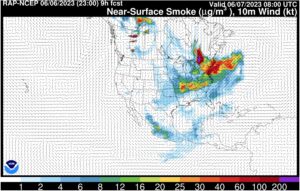
Forecast models show the smoke becoming even more concentrated over eastern Pennsylvania, much of New Jersey, the New York City metropolitan area, Connecticut, Rhode Island, and much of Massachusetts during the day today, which could make it difficult to breathe outside, especially for those with asthma and other respiratory ailments. NOAA’s HRRR high-resolution short-range computer forecast model says the amount of smoke around the New York City metro area will be even greater than it was yesterday.
Yesterday, according to the World Air Quality Index, New York City was considered the world’s most polluted city with the highest AQI reading of any major city anywhere on the globe.
Smoke from wildfire adds to particle pollution in the atmosphere. According to the EPA, particle pollution, also known as particulate matter (PM), consists of a mixture of solids and liquid droplets. Wildfires can drive hazard particle pollution levels outdoors and particle levels can become elevated indoors too when outdoor particle levels are high. Particles come in a wide range of sizes; those less than 10 micrometers in diameter are so small that they can get into the lungs. The smallest particles, those 2.5 micrometers or less in diameter, are called “fine” particles; these particles are so small, they can only be seen through an electron microscope.
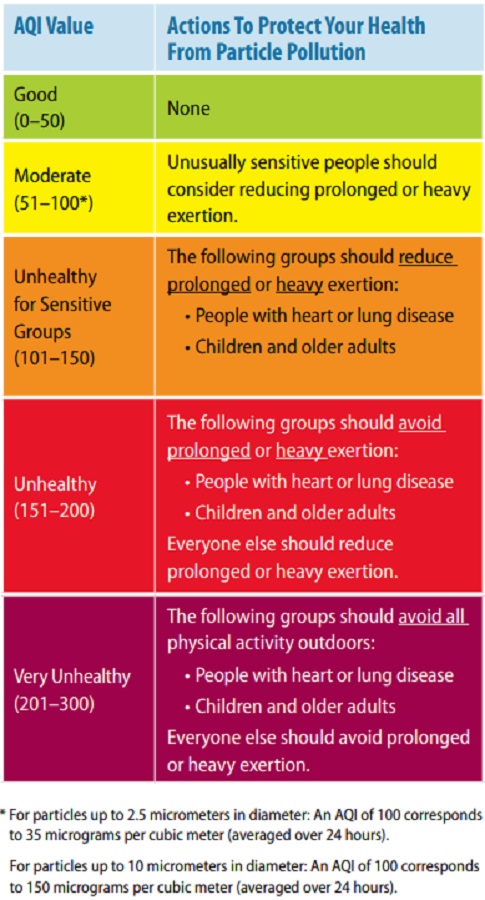
The EPA warns, “Particles smaller than 10 micrometers in diameter can cause or aggravate a number of health problems and have been
linked with illnesses and deaths from heart or lung disease. These effects have been associated with both short-term exposures (usually over 24 hours, but possibly as short as one hour) and long-term exposures (years).”
Sensitive groups for particle pollution include people with heart or lung disease, including heart failure and coronary artery disease, or asthma and chronic obstructive pulmonary disease , older adults who may have undiagnosed heart or lung disease, and children. The risk of heart attacks, and thus the risk from particle pollution, may begin as early as the mid-40s for men and mid-50s for women.
The EPA says that when people with heart or lung diseases are exposed to particle pollution, they are more likely to visit emergency rooms, be admitted to hospitals, or in some cases, die. Exposure to particle pollution may cause people with heart disease to experience chest pain, palpitations, shortness of breath, and fatigue. Particle pollution has also been linked to cardiac arrythmias and heart attacks.
“When exposed to high levels of particle pollution, people with existing lung disease may not be able to breathe as deeply or as vigorously as they normally would,” the EPA says. “They may experience symptoms such as coughing and shortness of breath. Healthy people may also experience these effects, although they are unlikely to experience more serious effects.”
To protect yourself from these smoke hazards, the EPA says exposure to such harmful air should be reduced. Depending on the AQI level and the health of the person, prolonged or heavy exertion should be avoided.
A variety of state or regional organizations have issued air quality alerts for the smoke. The New Jersey Department of Environmental Protection has issued a Code ORANGE air quality alert for the entire state. The Pennsylvania Department of Environmental Protection also issued a Code ORANGE alert for the Lehigh Valley, the Susquehanna Valley, and Berks County areas. The Delaware Valley Regional Planning Commission issued the same for the entire Philadelphia metro region. In Delaware, the Delaware Department of Natural Resources and Environmental Control has issued a Code RED air quality alert for the state. The Maryland Department of the Environment has also issued a Code RED air quality alert for the Maryland Piedmont region, Baltimore, and northeastern parts of the state. The New York State Department of Environmental Conservation has issued an Air Quality Health Advisory for the entire metro New York City region area too. The Metropolitan Washington Council of Governments and District Department of Environment in Washington, DC has issued a Code ORANGE air quality alert for the nation’s capital. The Massachusetts Department of Environmental Protection has issued an Air Quality Action Day for Fine Particulates; the Connecticut Department of Environmental Protection and the New Hampshire Department of Environmental Services have issued the same for many counties in their respective states.
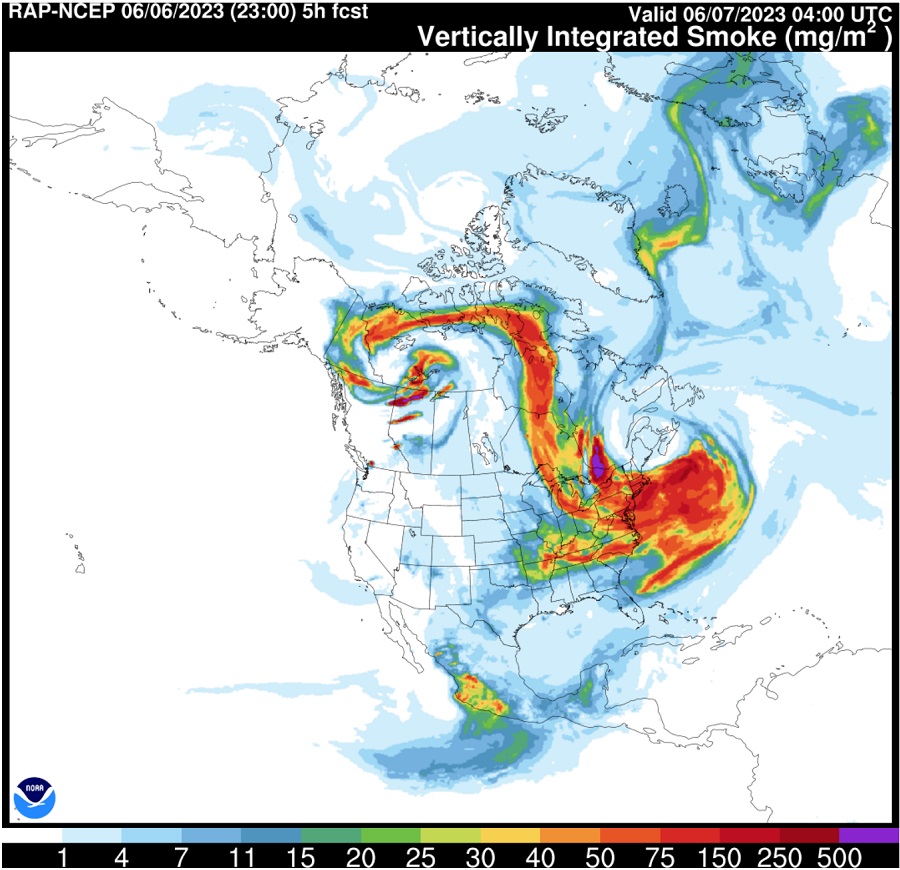
While smoke will enter the region from Canada and from the other fires burning in the northeast, the National Weather Service is providing advice to prevent the start of additional fires. The National Weather Service cautions: “Properly discard cigarettes; keep vehicles off of dry grass; avoid activities with open flames or sparks; avoid power equipment that creates sparks; obey burn bans; evacuate if fire/smoke is heading your way; evacuate if ordered to do so by local officials.”
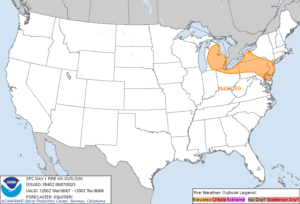
A combination of low relative humidity, breezy west to northwest winds, and dry fine fuels will lead to an elevated risk for fire spread with any potential fire ignitions today. The greatest fire weather threat will extend from much of Michigan to northern Ohio to western New York, much of Pennsylvania, northeastern Maryland, and most of Delaware and New Jersey.
Minimum relative humidity values this afternoon will range from 20-25% across the area. West to northwest winds will increase to around 10-15 mph with gusts up to 20 mph possible. Fuel moistures are very low, with much of the region having not experienced a widespread wetting rainfall in over 5 weeks.
The National Weather Service warns, “Any dry grasses, dead leaves, and other tree litter that ignite will have the potential to spread fire quickly.”
Additional fires will simply add to the amount of smoke in the air, making the air that much more unhealthy in local areas dealing with both regional smoke and local fires/smoke.